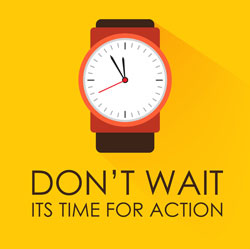There’s one thing that customers delight in and that’s being provided with service in a timely manner.
 During a recent client assignment, I noticed the frequency in which customers found themselves in the waiting mode. Waiting to be told what to do next. Waiting to be acknowledged. Waiting to be serviced.
During a recent client assignment, I noticed the frequency in which customers found themselves in the waiting mode. Waiting to be told what to do next. Waiting to be acknowledged. Waiting to be serviced.
Waiting is high on the how to antagonize customers list. Can you put your finger on the reasons your customers wait?
Here’s a few of the more common reasons:
Supply vs Demand – Oftentimes there’s just not enough personnel available (supply) to handle the number of customers (demand). Is the demand the result of a marketing campaign or new product release? Perhaps a glitch in your product has created an unexpected influx of customer inquiries or complaints.
When you know what the issue is, take a moment to proactively advise your customers. If yours is a call center, utilize the Interactive Voice Response (IVR) to advise customers that you’re aware of the issue and include an estimated resolution time, instructions to obtain a replacement product or whatever it is that you want to communicate.
Most customers will simply choose to take this as enough information and disconnect the call. Is it possible to place the same information on your website? Perhaps in a retail environment, data mining can assist in determining the peak periods for customer/employee interactions resulting in proper scheduling of personnel in accordance to historical data. These are just two examples for possibly alleviating stress for both customers and employees.
Seasoned vs Non-Seasoned Employee Ratio – Perhaps the “seasoned to not quite seasoned” employee ratio is somewhat on the low side resulting in a longer than normal transaction/customer interaction time. When there is not enough properly trained personnel available for customer interactions, more often than not, customers will find themselves in the wait mode.
However you describe this mode – queue, line, column, etc – most customers prefer not to be there. It’s important to combine great training with great employee relations to reduce personnel turnover. The more tenure an employee obtains, the more nimble he or she becomes at servicing customers. I have a saying – “Knowledge coupled with repetition creates experience. Experience assists in creating efficient interactions.”
Options for Self Service – It’s a good idea where possible to allow your customer to self-serve. Most customers today don’t mind serving themselves as long as the transaction is easy to complete. Oftentimes when given the option to self-serve for the checkout procedure, I’ll choose to do so rather than wait in line to be checked out by an employee.
What self-service opportunities are available within your organization? When the customer has the option to order products and services or set appointments via your website, is the process seamless and easy to complete? Are you able to verify the number of transactions actually completed via your self-service options vs those customers choosing to opt out to a live person (either via phone, web chat or in person)? Monitor your self-service options to ensure customers find it easy to complete interactions.
Customers are depending upon companies to provide prompt efficient service. Make sure your company is ready by checking to ensure Supply Meets Demand, that the Seasoned Vs Non-Seasoned Ratio indicates you’re successfully retaining tenured personnel and that your Options for Self Service are efficient and effective for the “I Like To Do It Myself” customer.
About the Author
Recognized as “one of seven useful Twitter people for retailers to follow” by Mystery Shopping Experts of the UK, Customer Service Speaker, Author and Consultant Errol Allen utilizes his 25+ years of practical hands on experience to assist organizations in developing customer service strategies for maximum customer retention. Errol believes that a systems mindset is critical to an organization’s success in providing great customer experiences.




